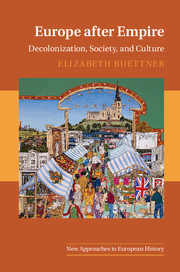Book contents
- Frontmatter
- Contents
- List of figures
- Acknowledgements
- Introduction
- Part I Decolonization for colonizers: Europe's transition to the postcolonial era
- Part II Migrations and multiculturalisms in postcolonial Europe
- Part III Memories, legacies, and further directions
- 9 Remembering and forgetting empires
- Epilogue: thoughts towards new histories of contemporary Europe
- Bibliography
- Index
9 - Remembering and forgetting empires
from Part III - Memories, legacies, and further directions
Published online by Cambridge University Press: 05 June 2016
- Frontmatter
- Contents
- List of figures
- Acknowledgements
- Introduction
- Part I Decolonization for colonizers: Europe's transition to the postcolonial era
- Part II Migrations and multiculturalisms in postcolonial Europe
- Part III Memories, legacies, and further directions
- 9 Remembering and forgetting empires
- Epilogue: thoughts towards new histories of contemporary Europe
- Bibliography
- Index
Summary
Introduction
In its exhibit entitled Mwana Kitoko – Beautiful White Man, the Belgian Pavilion at the 2001 Venice Biennale staged ten new paintings by Luc Tuymans, one of Europe's leading contemporary artists. At the British Pavilion two years before, Chris Ofili's Union Black (discussed in the previous chapter) had engaged with British national symbols and a transnational black culture reflecting the multicultural aftermath of empire; Tuymans’ contribution to the next Biennale in turn probed his own country's deeply problematic colonial and decolonization history itself. His Mwana Kitoko series challenged many long-standing Belgian understandings and fantasies about the Congo, starting with those that had taken centre stage when King Baudouin toured the colony in 1955 (see Chapter 4). Tuymans excavated André Cauvin's state-approved Bwana Kitoko documentary project produced in commemoration of the king's visit, contesting its assumptions at the most fundamental level by renaming it. In replacing ‘Bwana Kitoko’ (‘noble lord’) with ‘Mwana Kitoko’ (‘beautiful boy’), Tuymans reinstated a Congolese way of describing Baudouin in 1955 that the colonial authorities, finding it overly irreverent, had modified at the time. Adding ‘white man’ underscored the role of race in the king's emergent persona as a twenty-five-year-old who had recently ascended the throne in divisive circumstances after Belgium emerged from the trauma of Nazi wartime occupation.
Throughout his series, Tuymans subjected still-dominant Belgian narratives and memories of the Congo to critical scrutiny, not least by confronting the less-than-‘beautiful’ part that the ‘white man’ (including King Baudouin himself) played in Central African history. Three paintings recast Cauvin's film footage from the 1955 tour, respectively depicting Baudouin's majestic descent from his aircraft, his trip into Léopoldville by motorcade (portrayed by featuring African spectators watching the procession from the upper-floor window of a building), and the leopard skin laid down for him when he reached his destination (an image showing African hands dutifully straightening the skin together with the king's feet after walking across it). Tuymans set out to represent the rituals and pageantry of power while emphasizing its shadowy and unsettling nature – a power replete with clearly recognizable ceremonial trappings and scripted performances but in which the individuals involved lack clear facial features, or even faces.
- Type
- Chapter
- Information
- Europe after EmpireDecolonization, Society, and Culture, pp. 417 - 490Publisher: Cambridge University PressPrint publication year: 2016

